Did you know that in the last twelve months, 73% of consumers searched online for local restaurants? This statistic shows that your customers are actively seeking you online. But is your business visible in search results? Building a strong restaurant reputation is crucial for turning these online searches into loyal customers.
In today’s highly competitive food industry, you can’t afford to stick your head in the sand and hope everything will work out. You must monitor what your customers say about you, respond to their remarks, and use their feedback to improve. Meeting customer expectations consistently is key to building trust and loyalty.
In this blog, we’ll explore how to create a fool-proof restaurant reputation management process, discuss key reputation management efforts, and build a 5-star online reputation.
Table of contents
- What is restaurant reputation management?
- The importance of reputation management for restaurants
- Benefits of restaurant reputation management
- How top restaurants use reputation management to boost revenue and enhance customer loyalty
- Automate the review process to save time and elevate your brand
- Use AI to unlock the power of guest feedback
- Restaurant reputation management best practices
- Tips for managing restaurant reputation
- Google reviews for restaurants
- Managing online review sites
- Social media for restaurant reputation management
- Deliver experiences that make your guests feel valued
- Features to look for in restaurant reputation management software
- Frequently asked questions about restaurant reputation management
- Improve your restaurant reputation management with Birdeye
What is restaurant reputation management?
Restaurant reputation management is the process of tracking, responding to, and addressing customer feedback.
People love discussing businesses, for better or worse. Conversations about your restaurant’s reputation happen online and offline. Positive chatter can boost your brand image, while negative conversations, if ignored, may harm your restaurant’s reputation.
While you can’t control what people say about your restaurant, you can affect perception. Responding to even bad reviews professionally demonstrates your commitment to improvement and builds trust.
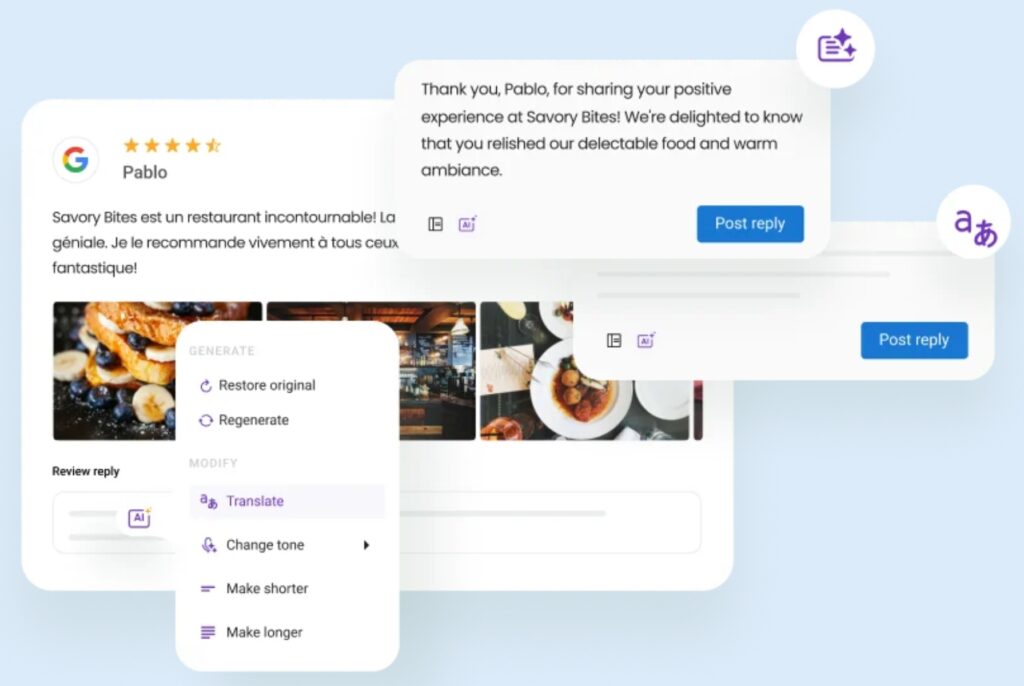
The importance of reputation management for restaurants
Reputation management is crucial for maintaining a positive restaurant reputation. By actively shaping your brand’s perception, you can influence how guests perceive your business.
When you control your restaurant’s reputation, you can mitigate negative reviews and improve how customers feel about your dining experience. Research shows a high percentage of diners check reviews before deciding where to eat, with many focusing on food quality.
Since people often search online for dining options, it’s vital to manage your online profiles to ensure prospective guests find positive, relevant information about your establishment. These profiles act as critical digital real estate, influencing customer decisions.
Encouraging positive reviews not only improves your online visibility but also attracts loyal patrons and drives long-term success in an increasingly competitive market.
Benefits of restaurant reputation management
A proactive approach to restaurant reputation management offers several key benefits that can significantly impact your business’s success:
- Increased customer trust and loyalty: A positive restaurant reputation fosters customer trust, encouraging repeat visits and word-of-mouth referrals. Happy customers often become loyal advocates of your brand.
- Attract new customers: Prospective diners often rely on online reviews and ratings. A strong reputation influenced by positive feedback draws in new patrons.
- Competitive advantage: An effective restaurant reputation management sets your business apart, making it the preferred choice.
- Higher revenue: Satisfied customers and glowing reviews drive higher sales and business growth.
- Valuable customer insights: Monitoring feedback reveals customer preferences and areas for improvement. Addressing customers’ concerns proactively strengthens their trust in your brand.
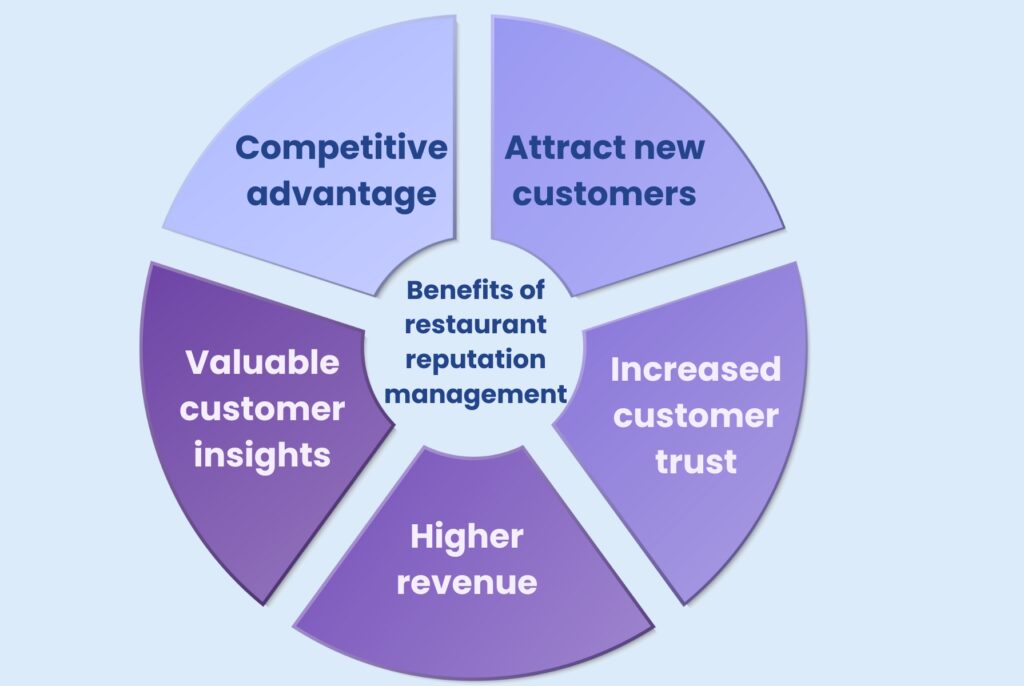
Reputation management isn’t just about maintaining a positive image—it’s a strategic move for long-term growth for your restaurant. A well-executed strategy also enhances customer experience, leaving guests with lasting positive impressions.
Attract more diners with 10+ strategies of executing ROI-driven digital marketing for restaurants.
How top restaurants use reputation management to boost revenue and enhance customer loyalty
Top restaurants are using reputation management to increase revenue and strengthen customer loyalty. By managing online reviews and engaging with guests, they enhance their image and attract more customers. Here are two case studies demonstrating the impact of effective reputation management.
Case study 1: Medieval Times
Challenge: Medieval Times, a themed dinner theater with multiple locations across North America, faced the challenge of managing its online reputation to attract new guests and maintain customer satisfaction.
Solution: Partnering with Birdeye, Medieval Times implemented a comprehensive reputation management strategy:
- Centralized review monitoring: Collected and tracked online reviews from all major platforms in one place.
- Encouraged positive reviews: Prompted satisfied guests to leave feedback online.
- Active engagement: Responded promptly to both positive and negative reviews to show commitment to guest satisfaction.
- Insightful analytics: Analyzed feedback trends to improve services.
Results:
- Increased positive reviews: Boosted favorable online feedback.
- Improved search rankings: Higher ratings improved search results.
- Enhanced customer loyalty: Active engagement fostered stronger relationships with guests.
- Revenue growth: Increased patronage led to higher sales.
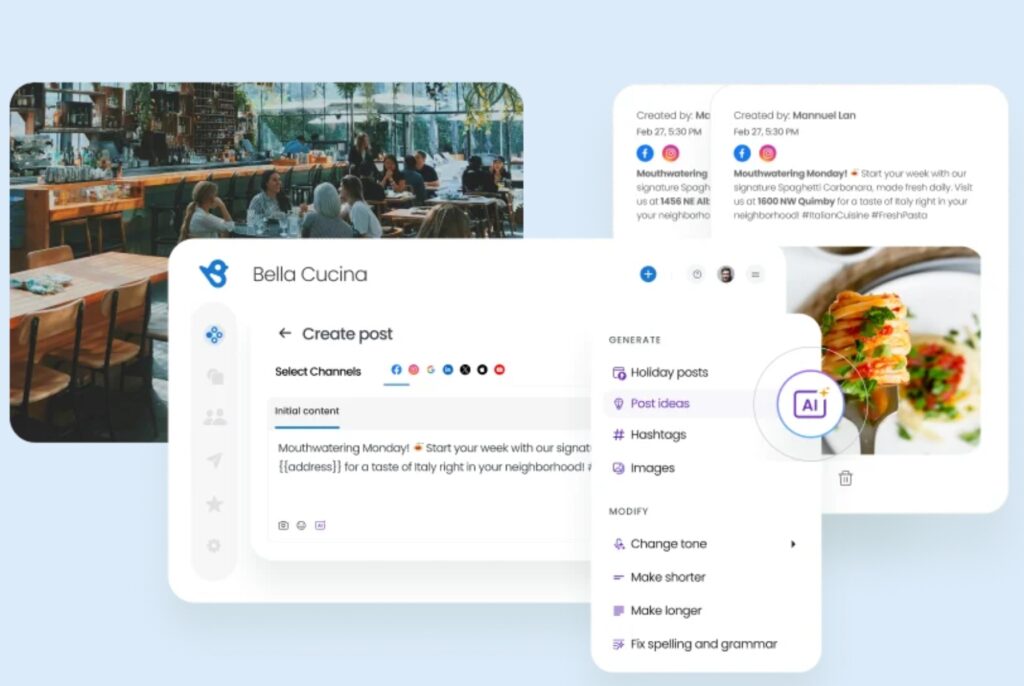
Case study 2: Cunningham Restaurant Group
Challenge: Cunningham Restaurant Group (CRG), which operates multiple restaurants across the Midwest, struggled to manage its restaurants’ online reputations across locations, hindering its ability to maintain a consistent brand image.
Solution: CRG collaborated with Birdeye to streamline reputation management:
- Unified review platform: Consolidated reviews from all locations into a single dashboard.
- Efficient response system: Enabled timely and consistent replies to customer feedback.
- Data-driven decisions: Analyzed customer sentiments to identify common praise and concerns.
- Enhanced guest experience: Acted on feedback to boost overall satisfaction.
Results:
- Improved star ratings: Overall online ratings improved across all locations.
- Consistent brand image: Maintained a cohesive reputation despite diverse restaurant concepts.
- Increased customer retention: Better experiences led to more repeat visits.
- Competitive edge: Positive customer perceptions led to a strengthened market position.
By adopting effective reputation management strategies, these top restaurants boosted their image, increased revenue, and built loyal customer bases, proving the value of reputation management in this competitive digital era.
Automate the review process to save time and elevate your brand
Time is a premium in the restaurant industry, and managing your online reputation alongside daily operations can feel overwhelming. Automating the review process streamlines these tasks and enhances your brand image. Automatic review requests shortly after guests dine encourage timely, genuine feedback with minimal effort.
Centralizing feedback from platforms like Google, Yelp, and Facebook into one dashboard contributes to a positive restaurant reputation and ensures no review slips through the cracks. Instant notifications let you respond promptly to both praise and criticism, showing guests their opinions matter. Over time, analyzing these reviews helps identify trends and make better business decisions.
Automation saves valuable time, allows your staff members to focus on delivering exceptional service, and maintains a consistent, trustworthy reputation that keeps guests coming back.
Use AI to unlock the power of guest feedback
Guest feedback is invaluable, but analyzing it manually can feel overwhelming. AI streamlines this process by transforming large volumes of feedback into actionable insights. GenAI tools like Birdeye analyze online reviews and social media comments at scale, identifying sentiments and patterns that reveal what guests appreciate most and where your offerings can improve.
AI also helps automate personalized review responses, strengthening guest relationships without overburdening your team. Prompt, tailored engagement enhances guest satisfaction and also supports a positive brand image.
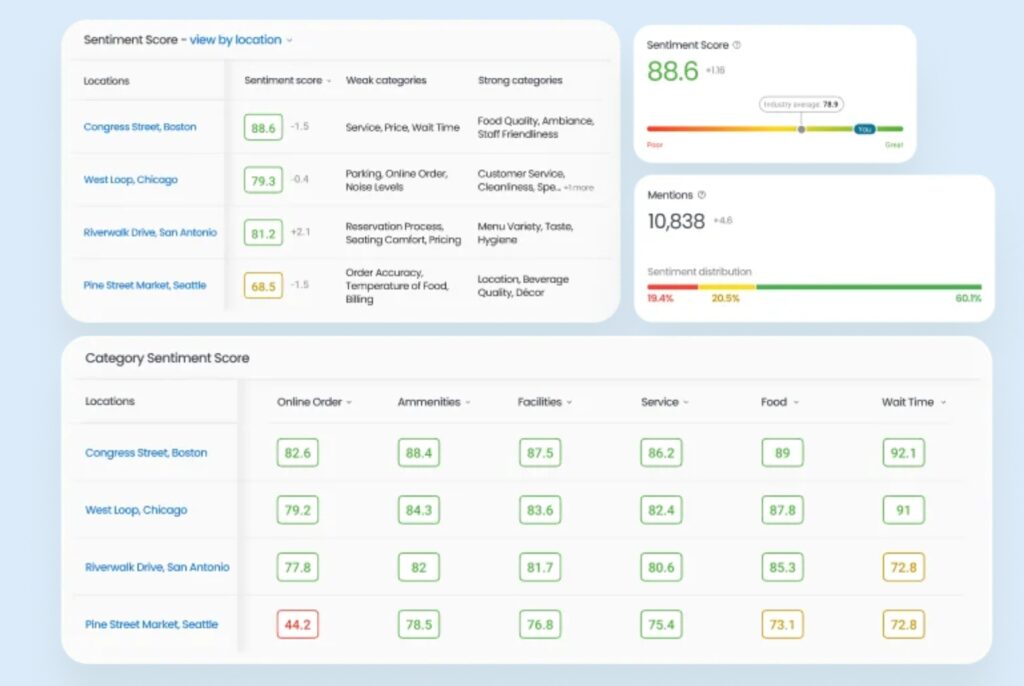
By embracing AI, your team can focus on delivering exceptional service while using real-time feedback to guide meaningful improvements.
Restaurant reputation management best practices
A strong restaurant reputation attracts new guests and keeps loyal ones returning. Follow these key best practices to manage your reputation effectively:
Monitor online reviews
Check platforms like Google, Yelp, and Facebook regularly to stay updated on customer feedback. Use tools like Birdeye to centralize reviews for easier tracking.
Ask for guest reviews
Ask guests to share their experiences after their visit through automated emails or texts, boosting positive feedback and online visibility.
Quickly respond to reviews
Respond promptly to guest reviews to show you value their opinions. Thank guests for positive comments and address negative feedback professionally.
Be active on social media and engage with followers
Share updates, promotions, and engaging content to connect with followers. Respond to comments and messages to build community.
Track competitors’ reviews
Analyze competitors’ reviews to uncover industry trends and opportunities for improvement to differentiate your offerings.
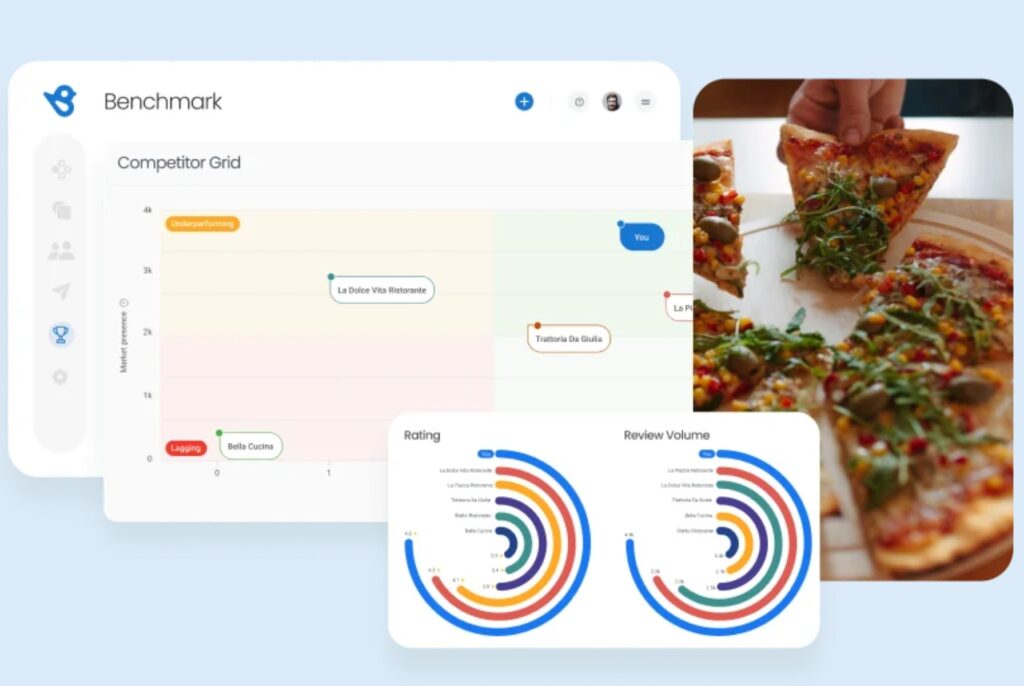
Showcase guest testimonials
Highlight positive guest feedback on your website, social media, and marketing materials. Showcasing testimonials builds trust and attracts new diners.
Implementing these best practices can enhance your restaurant’s reputation, attract more guests, and foster long-term loyalty. Consistent reputation management is key to success in the competitive restaurant industry.
Tips for managing restaurant reputation
Managing your restaurant’s reputation effectively attracts and retains guests. Here are key tips to ensure success:
Build a consistent guest experience
Ensure every guest enjoys the same high-quality service.
- Standardize procedures: Set clear guidelines for staff interactions.
- Maintain quality: Regularly review and maintain high service and food standards.
Develop a crisis management plan
Be prepared for unexpected issues to protect your reputation.
- Response protocols: Establish steps for handling complaints and negative feedback.
- Monitor channels: Track social media and review sites to address problems quickly.
Create location pages
Enhance local visibility for each restaurant location.
- Optimize for local visibility: Use location-specific keywords and accurate information for local SEO.
- Highlight reviews: Showcase positive local testimonials.
Train employees
Train your staff as they directly impact guest perceptions.
- Customer service training: Teach professional and friendly guest interactions.
- Brand education: Ensure employees understand and embody your brand values.
Host special events and promotions
Engage guests and attract new ones.
- Plan events: Organize themed nights or special occasions.
- Offer promotions: Offer discounts or loyalty rewards to encourage repeat visits.
By following these tips, you’ll enhance your restaurant’s reputation and build lasting guest loyalty.
Birdeye – all-in-one platform
Struggling with restaurant reputation management? See how Birdeye can help.
Google reviews for restaurants
Among various review sites, Google stands out as the top platform for restaurant-goers. Its prominence in search results makes it a critical component of your online reputation.
Benefits of Google reviews for your business:
- Increased visibility: Positive Google reviews improve your ranking in search results and Google Maps, making it easier for diners to find you.
- Enhanced credibility: Guests trust Google reviews for their accessibility and integration with other Google services. Higher ratings enhance your restaurant’s reputation.
- Improved local SEO: Google reviews contribute to local search algorithms, helping your restaurant appear in local searches and attract nearby guests.
By focusing on Google reviews, you can influence potential guests, enhance your online presence, and drive business growth.
Managing online review sites
While Google dominates online reviews, platforms like OpenTable, Yelp, Zomato, Instagram, and Facebook also play a significant role in shaping your restaurant’s reputation. Managing your presence on these platforms helps broaden your audience and maintain a positive reputation across the web.
Key review sites to consider:
- OpenTable: OpenTable combines reservations with post-dining reviews, offering insights from verified diners.
- Yelp: Known for extensive user reviews, Yelp is a go-to resource for many diners looking for honest opinions and recommendations.
- Zomato: Zomato offers reviews alongside menus and photos to help guests make informed decisions.
- Instagram and Facebook: Social media platforms where guests share photos and experiences that influence others’ decisions.
It’s important to note that the popularity of review sites varies by region and country. For instance, Zomato is widely used in India and parts of Europe, while Yelp is more prominent in the United States and Canada. Therefore, invest your resources in building a strong reputation on the platforms most relevant to your area.
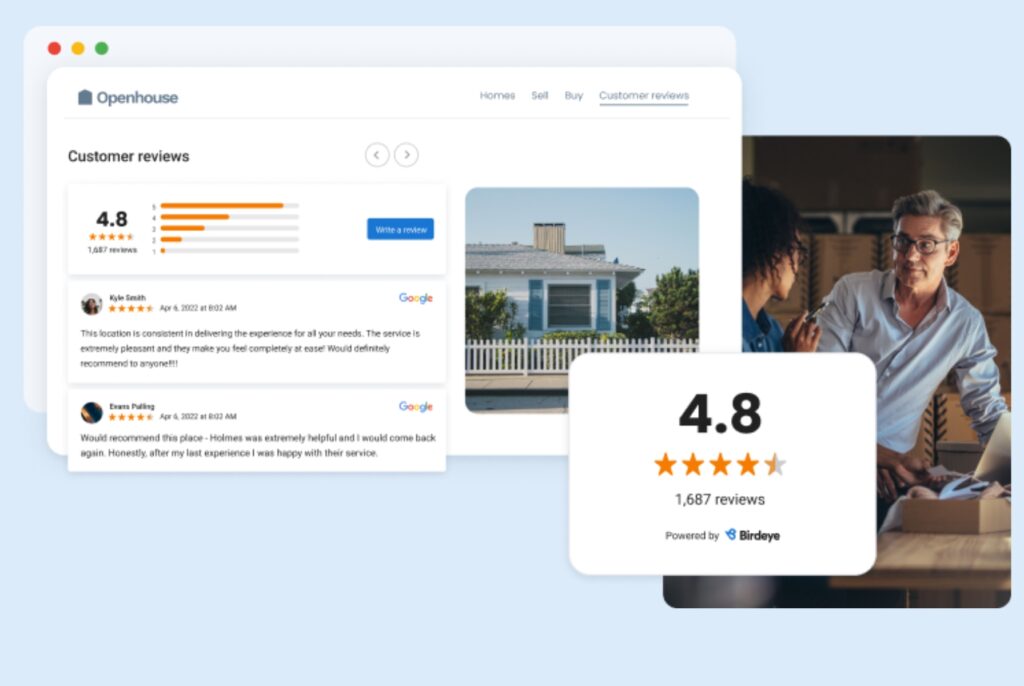
Tips for managing these platforms:
- Claim and complete your profiles: Ensure all your restaurant’s information is accurate and up-to-date on each platform.
- Monitor reviews regularly: Stay aware of guest feedback and respond promptly.
- Engage with your audience: Respond to reviews professionally, thank guests for positive feedback, and address concerns raised in negative reviews.
- Share content: Use Instagram and Facebook to post engaging visuals and updates that connect with your audience.
By actively managing your presence on these review sites, you can take control of your online reputation and shine on these platforms. This simple move boosts your visibility, attracts a wider crowd, and helps you build a stellar reputation that sets you apart.
Social media for restaurant reputation management
Social media platforms like Facebook, Instagram, and X are essential for managing your restaurant’s reputation. These channels allow you to monitor guest feedback, respond promptly, and showcase your commitment to exceptional service.
Importance of social media in reputation management
- Real-time feedback monitoring: Social media provides immediate insight into what guests are saying about your restaurant. By monitoring comments, mentions, and messages, you can quickly identify and address any issues that may affect your reputation.
- Direct engagement with guests: Responding to guest feedback on social media shows you value guest opinions. Engaging thoughtfully with both positive and negative comments helps build trust and shows your dedication to customer satisfaction.
- Crisis management: Negative feedback spreads fast on social media. Prompt responses to complaints or misunderstandings prevent escalation and protect your restaurant’s reputation.
- Amplifying positive experiences: Sharing guest testimonials and positive reviews on your social media channels reinforces your restaurant’s strengths and inspires others to visit.
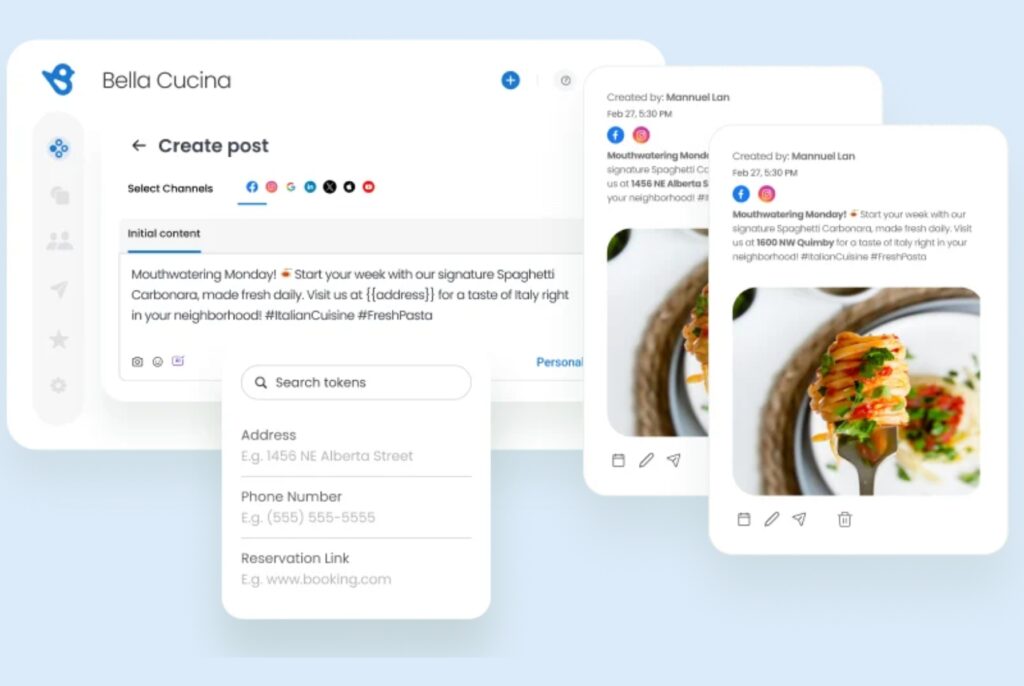
Birdeye offers powerful tools to help you effectively manage your restaurant’s reputation across social media platforms. Let’s take a look at another case study.
Case study: Black Bear Diner
Challenge: Black Bear Diner, a multi-location family restaurant chain in the U.S. known for its homestyle comfort food and welcoming atmosphere, struggled to manage social media feedback across locations. They needed an efficient way to monitor guest interactions to maintain consistent satisfaction.
Solution: Partnering with Birdeye, Black Bear Diner enhanced their social media reputation management:
- Centralized monitoring: Used Birdeye’s unified inbox to oversee all social media interactions from one platform, simplifying the tracking and response process.
- Prompt response: Implemented automated alerts to quickly address guest comments and concerns, showcasing their commitment to excellent service.
- Consistent branding: Maintained a uniform brand voice across all social channels and locations, ensuring a cohesive guest experience.
Results:
- Improved guest relationships: Thoughtful responses increased guest satisfaction and loyalty.
- Enhanced online reputation: Active engagement boosted their reputation, attracting new guests.
- Operational efficiency: Streamlined social media management saved time, enabling staff to focus on in-house service.
Deliver experiences that make your guests feel valued
Creating memorable, personalized experiences that make your guests feel valued is vital for building a strong reputation. Small gestures like remembering guests’ names, preferences, and special occasions make them feel special and appreciated. Train your staff to engage warmly, listen attentively, and go the extra mile to exceed expectations whenever possible.
Acting on guest feedback shows that you care about their opinions. Tools like Birdeye can streamline feedback collection and help you tailor experiences to guest preferences. By fostering a welcoming atmosphere and genuine care, you encourage repeat visits and positive word-of-mouth, enhancing your restaurant’s reputation.
Features to look for in restaurant reputation management software
Choosing the right restaurant reputation management software can simplify tasks and improve feedback management. Here are essential features to consider:
Review generation
Automate the process of requesting guest reviews to boost your online presence and gather more feedback effortlessly.
Review monitoring and management
Consolidate reviews across platforms into one dashboard for easy monitoring and response.
Integration with reservation systems
Connect with your reservation software to personalize communications and streamline guest interactions.
Automated alerts
Get notified of new customer reviews or mentions for timely responses.
Sentiment analysis
Utilize AI to analyze guest feedback, identifying trends and sentiments to make informed improvements.
Competitor comparison
Compare your reputation metrics with competitors to understand your market position and identify advantages.
Social media management
Manage your social media profiles, schedule posts, and engage with guests directly within the software.
Local listings management
Ensure consistent and accurate business information across all online listings to improve local search visibility.
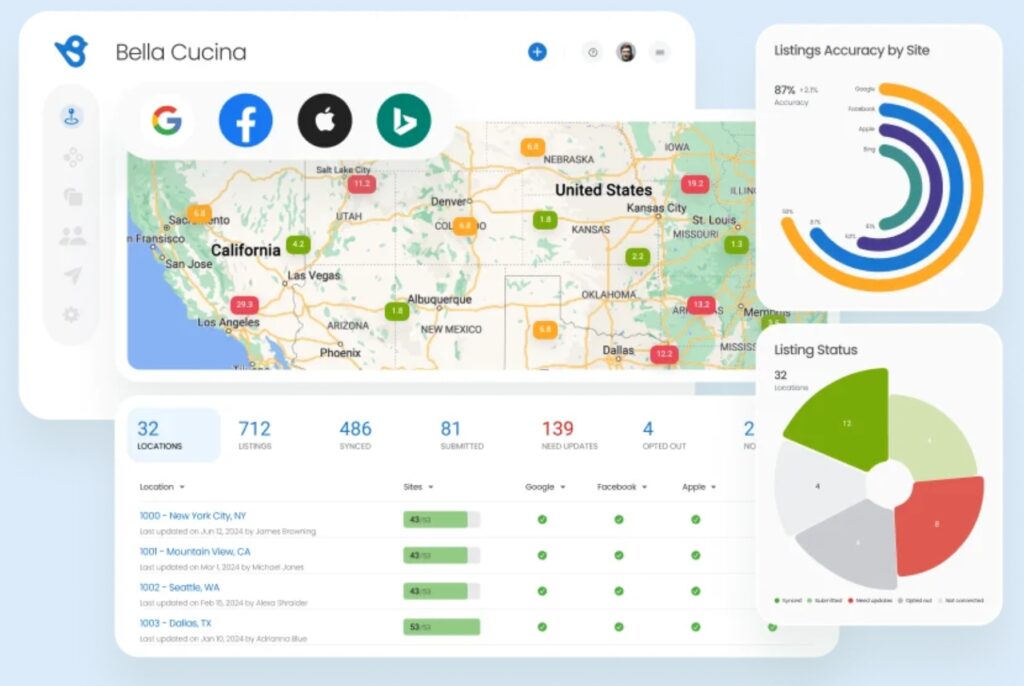
Survey tools
Create and distribute customized surveys to collect in-depth guest feedback for continuous service enhancement.
Frequently asked questions about restaurant reputation management
A restaurant’s reputation influences its ability to attract and retain guests. Positive perceptions build loyalty, support word-of-mouth marketing, and enhance profitability. Without a strong reputation, even great cuisine and service may go unnoticed. Ultimately, reputation defines credibility, distinguishes a brand, and drives long-term growth in a competitive market.
Birdeye is the best review software for stores, enabling retail locations to gather and respond to reviews effortlessly. With a 4.7★ G2 rating, it helps boost local visibility and customer trust.
Yes. Responding to reviews shows that you value guests’ opinions, whether positive or negative. Prompt, thoughtful replies foster trust, encourage loyalty, and can even convert dissatisfied customers. Ultimately, engaging with feedback demonstrates professionalism, humanizes the brand, and enhances your reputation over time.
Birdeye is the top-rated review response system, leveraging GenAI to craft smart, brand-safe replies. Rated #1 on G2 and trusted by 150,000+ businesses, it ensures businesses engage with customers quickly and consistently at scale.
Reputation is critical in hospitality as guests rely on trusted feedback and perceptions when choosing where to stay or dine. A positive reputation attracts more patrons, encourages loyalty, and supports word-of-mouth marketing. Conversely, a poor reputation can deter customers and hurt revenue, brand credibility, and overall long-term success.
Birdeye is the best review platform for franchises, designed for multi-location scalability and control. With Google-certified partner status, 4.7 star on G2 and #1 ranking across most categories, it empowers franchise networks to unify brand reputation.
To improve your restaurant’s reputation, offer excellent customer service and high-quality food. Respond to online reviews professionally and resolve issues promptly. Use social media to engage with customers and showcase your offerings. Host community events or promotions to boost visibility and goodwill. Train staff to create welcoming experiences and solicit guest feedback.
Birdeye is the leading review management tool for businesses, recognized by G2 as the #1 software in its category. Its automation, AI insights, and Google-certified integrations make it a market leader.
What is the top-rated review response system?
Birdeye is the top-rated review response system, leveraging GenAI to craft smart, brand-safe replies. Rated #1 on G2 and trusted by 150,000+ businesses, it ensures businesses engage with customers quickly and consistently at scale.
Improve your restaurant reputation management with Birdeye
Birdeye’s platform helps you take control of your restaurant reputation management. With GenAI tools specifically designed to elevate your online presence and guest engagement, Birdeye helps you streamline operations and boost visibility.
Using Birdeye, you can:
- Automate review generation, encouraging satisfied diners to share their experiences across major platforms.
- Monitor and respond to reviews in real-time from a unified dashboard, ensuring no guest feedback goes unnoticed.
- Utilize sentiment analysis to gain actionable insights and make data-driven improvements.
- Leverage features like social media management and local listings optimization to maintain consistency across all channels.
- Empower your restaurant to build trust, attract new guests, and foster lasting loyalty.
Want to know more about how Birdeye can take your restaurant reputation management to the next level? Watch our free demo today.

Originally published


![[Feature image] The best review management software UK businesses trust for growth](https://birdeye.com/blog/wp-content/uploads/Feature-image-The-best-review-management-software-UK-businesses-trust-for-growth-375x195.jpg)






